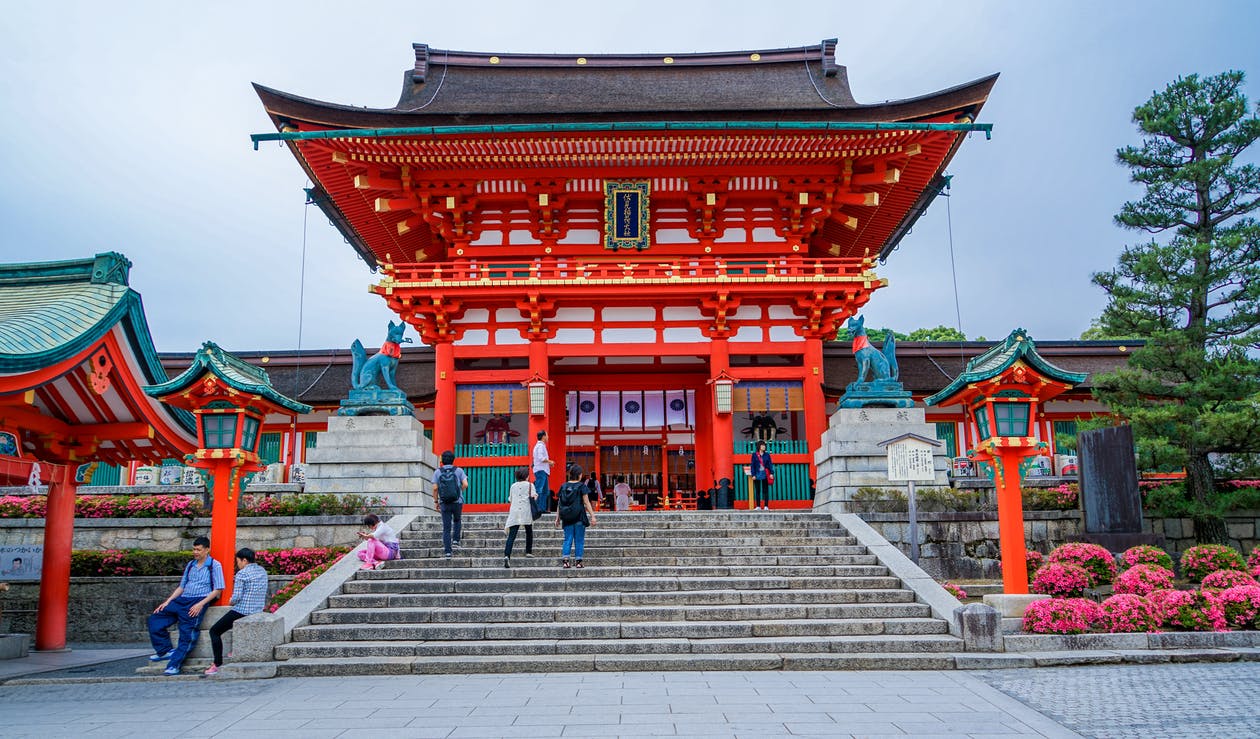
Japanese Formality: How to Use Formal and Informal Japanese
Japan is famous for its formality and politeness, and Japanese people have earned a reputation for having excellent manners.
So how is a newcomer to the language supposed to navigate Japanese formality?
Fortunately, if you’re not Japanese, you’re not expected to know every little detail of how formal Japanese works.
However, knowing the basics of Japanese politeness will earn you points with your Japanese friends and colleagues.
With a little digging and a lot of hard work, you’ll be able to master Japanese formality in no time!
Contents
Download: This blog post is available as a convenient and portable PDF that you can take anywhere. Click here to get a copy. (Download)
Formal Japanese
Formal Japanese can be divided up into three major categories: 丁寧語 (ていねいご, polite language), 尊敬語 (そんけいご, honorific language) and 謙譲語 (けんじょうご, humble language).
Depending on the situation and the statuses of those involved, the type of formal Japanese you use will be different:
- For everyday interactions with strangers, standard 丁寧語, teinuigo will do just fine.
- When speaking to a boss or a teacher, 尊敬語, sonkeigo is used to exalt them and their actions.
- And if you’re talking about yourself, 謙譲語, keigo will knock you down a few pegs, making you sound modest.
Like it or not, formal Japanese is important to understanding Japanese. It’s used to show respect to someone of a different social rank. Using formal and polite speech when speaking to someone older or socially superior to yourself, such as teachers, bosses, elders and upperclassmen, is considered good manners in Japan. Even if you don’t have to use them personally, these expressions are common in everyday Japan, and without a basic grasp of them, some confusion is going to take place.
Why Learn Formal Japanese
Learning formal Japanese will help you:
- Understand Japanese culture: Looking at the culture of Japan will help you understand how and where polite speech comes from. Japan has a system called uchi-soto, 内外 (うちそと), which translates to “inside and outside,” serving to group the people in one’s life into insiders (内) and outsiders (外). 内 is an “inner circle” of people you know, such as family, classmates, and colleagues. 外 is basically all those who are not a part of your circle.
These circles shift and change depending on the social situation you find yourself in, so it’s important to pay attention. (This is one reason why “reading the atmosphere” is so important in Japan!)
- Gain insight into communication: When it comes to communicating with others, Japan has a reputation for being extremely polite. Politeness is highly valued in Japan, and this is not done only by keeping quiet on trains, bowing deeper to your boss, or pouring your guest drinks, but also by humbling yourself with words.
Formal Japanese plays directly into politeness, and depending on how the conversation partner relates to you socially, the manner in which you speak will change. Whenever Japanese people speak with each other, they consider each other’s age, friendship, social status and more. Learning formal Japanese will let you know who’s who and how people are positioned in any given social situation.
- Navigate Japan more easily: These expressions are heard everywhere. If you’re only used to the common verb and suddenly encounter that verb’s formal form, suddenly you’re left lost as to what exactly is going on! With a basic understanding of formal Japanese under your belt, you’ll be able to order from a coffee shop or understand announcements more easily.
Elements of Formal Japanese
Social Hierarchy and Familiarity
When determining which level of formality to use, social hierarchy, or social rank, needs to be kept in mind at all times. Where you stand in your relationship with someone else determines how you speak to them.
The basic pecking order puts parents above children, teachers above students, bosses above employees and elders above younger people. When Japanese people speak to each other, they consider the rank of the other person and adjust their language accordingly. For instance, you wouldn’t talk to your teacher in the same way you’d talk to your little sister.
How well you know the other person also plays a part in politeness. Families tend to speak more casually with one another, while strangers will use more formal terms. Good friends will drop the formalities entirely and throw all kinds of slang around.
Behavior and Gestures
Behavior and mannerisms are important in showing politeness, too. However, what two people think of as polite may be very different!
If you grew up like me, you were told not to slurp your soup or noodles, since making noise while eating is rude. On the other hand, slurping is considered normal in Japan! Japanese people will slurp bowls of miso soup as well as noodles, which can be a bit surprising if you’re not used to it. But don’t take this as a sign that you should eat noisily—loud chewing is just as impolite in Japan as it is in the West.
Bowing is perhaps the most famous polite gesture done in Japan. But did you know that the type of bow used actually affects how polite it is? A short bow at about 15° is appropriate for a casual greeting. A 30° bow is used for greeting strangers and bosses, and a 45° angle conveys deep respect or an apology.
These physical elements are as much a part of polite speech as the actual words, so it’s important to learn them!
Japanese Polite Form
After you’ve introduced yourself, it’s time to make a good impression by speaking politely. The standard desu / masu form is appropriate regardless of the status of the person you’re speaking to. If you’re asking directions from a stranger on the street, this form is your safest bet.
When your Japanese friend introduces you to their friends, it’s also appropriate to use polite forms. You don’t know these people, after all! However, they may switch to casual form after a bit, in which case you might want to change gears as well.
In the office, usage of polite forms is standard. No matter how well you may get along with Mr. Tanaka from accounting, so long as you’re at work, you two will be using polite forms with each other. Save the informalities for the nomikai after work!
Japanese Honorifics
You can’t talk about Japanese without coming across honorifics. From the standard さん, (san, Mr./Ms.) and 先生 (sensei, せんせい, teacher) to the more unfamiliar 部長 (buchyou, ぶちょう, department manager) and 閣下 (kakka, かっか, your excellency), there’s an honorific for every position in Japanese society. When speaking about someone, knowing what honorific to use is a must.
So how do you figure it out? You’ll need to cover all the standard Japanese honorifics!
However, if you’re in a casual situation with a friend, or if someone wants to get closer to you, they may bring up 呼び捨て (yobisute, よびすて, dropping the suffix). This means that the person you’re hanging out with really likes you and wants to do away with the formalities of honorifics.
Business Japanese Formalities
If you’re in a business situation, the rules will be a little different. The Japanese business world is extremely strict and has rules for every single social interaction, from bosses to upper management to speaking to representatives of other companies. So you’ll need to brush up on specific business Japanese vocabulary.
あいづち , Aizuchi
Regardless of the level of formality, an easily overlooked yet crucial part of Japanese conversation is あいづち (aizuchi, conversational noises). Employing aizuchi lets the other person know you’re listening, and they’re much more frequent than the similar “uh-huh, yeah” in English.
In fact, its lack of usage among Japanese learners (especially English speakers) is more frustrating to Japanese people than any slip in formality! So do your future Japanese conversation partner a favor and get familiar with aizuchi.
敬語 , Keigo
By mastering Japanese keigo, you’ll not only have greater success navigating the office, but perhaps you’ll have a bit of a one-up on your Japanese colleagues!
Keigo is used in a variety of settings, but most commonly you’ll hear it in:
- Train stations
- Department stores
- Restaurants
- Convenience stores
- TV
In these situations, it’s the customer or the viewer that’s being spoken to. Flyers, clerks and broadcasters are are all addressing the person who will be receiving their service, and in Japan, the customer is king. That’s why, when you hear a clerk using one of these expressions on you, you don’t need to reply in kind. In fact, you shouldn’t! If you want to be polite, all you need to do is thank them or give a little nod of the head.
Practicing Formal Japanese
The best way to practice your formal Japanese is to listen to it. Even if you don’t live in Japan, thanks to the internet, there are all sorts of resources right at your fingertips to get on track to grasping the sounds of Japanese!
- TV: Television is a great way to learn Japanese while entertaining yourself. While it can be difficult to access these networks outside of Japan, NHK World and News24 can be accessed in the US.
- YouTube: YouTube is a wonderful tool for learning, and there are a wide variety of Japanese YouTube channels available to watch!
- FluentU: You can find authentic media clips on FluentU. Since these are presented with dual-language subtitles (as well as optional furigana), you’ll be able to keep up with the videos easily, and pick up on the kind of language being used.
FluentU takes authentic videos—like music videos, movie trailers, news and inspiring talks—and turns them into personalized language learning lessons.
You can try FluentU for free for 2 weeks. Check out the website or download the iOS app or Android app.
P.S. Click here to take advantage of our current sale! (Expires at the end of this month.)

6 Common Formal Japanese Expressions
1. いらっしゃいます (irasshaimasu)/ 参ります (mairimasu, まいります)
Meaning: To go/come; to be
Irasshaimasu is respectful songeigo, while mairimasu is humble kenjuougo. Every store you enter will greet customers, either personally or over an intercom, with いらっしゃいませ (irasshaimaise), which literally means “someone honorable is here.” It’s important to note that it’s not necessary to reply, and you definitely shouldn’t repeat it back to the clerk!
Mairimasu is often heard in train stations when the train is arriving, you will encounter まもなく電車が参ります (mamonaku denshya ga mairimasu,まもなくでんしゃがまいります) over the intercom or on a signboard, and translates to “the train is now humbly arriving.” This just means that your train is pulling in now, so it’s time to hop on board.
2. 召し上がります (meshi agarimasu, めしあがります)/ いただきます (itadakimasu)
Meaning: To eat/drink, to receive
Meshi agarimasu is the respectful form, and itadakimasu is humble. When you’re at a cafe or a fast food restaurant, the cashier may ask こちらでお召し上がりですか?(kochira de omeshi agarimasu ka?) meaning, “Will you be eating here?” You’ll also encounter the phrase on food packaging, as well as if someone gifts you food.
You may have heard that Japanese people always say itadakimasu before eating. It’s a simple, polite expression to show your gratitude for the food. But did you know it can also be used in other situations? When receiving an object, people will say itadakimasu as well, to show gratitude to the giver for receiving food, a gift or even their time.
3. ご存知ですか (gozonji desu ka, ごぞんじですか)
Meaning: Did you know~?
This is used to ask questions to someone in a polite way. When watching TV interviews, you’ll hear this word a lot when the anchor is asking the audience a question, or during commercials. You can also use this phrase with superiors or strangers, which is sure to earn you some bonus points for being so well-mannered.
4. ご覧ください (goran kudasai, ごらんください)
Meaning: Please take a look.
Shopkeepers will use this phrase frequently, saying どうぞご覧ください!(douzo goran kudasai) or “Have a look around!” when you enter the store. Signs will also use this to try and get your attention. And if you’re on a guided tour, your guide may use this phrase to point out something that’s worth seeing, so keep your ears perked if you don’t want to miss the best part of the tour!
5. なさいます (nasaimasu) / いたします (itashimasu)
Meaning: to do
Cashiers and hotel concierge will use this form when speaking of services they’ll be doing for you. If you made a reservation at a hotel, the concierge may ask ご予約はいつなさいましたか (goyoyaku ha itsuna saiimashita ka, ごよやくはいつなさいましたか, When did you make your reservation?), using the polite form to ask when you, the guest, made this reservation.
When your turn comes up after you’ve been waiting in line, the clerk or attendant will say お待たせいたしました (omatase itashimashita, おまたせいたしました, I’m sorry to keep you waiting). Train stations will also use まもなく到着いたします (mamonaku tou chyaku itashimasu. まもなくとうちゃくいたします).
6. いかがですか (ikaga desu ka)
Meaning: “How about~?”/ “How is~?”/ “How do you like it?”
This phrase is useful in a variety of shopping situations. When you’re trying on clothes or testing products, a clerk may ask this in order to check in on you. For instance, if you tell the clerk you’re looking for some sneakers, they may offer a pair and ask これはいかがですか? (kore wa ikaga desu ka?), which means “How do you like these?” If you like them, you can say それにします (sore ni shimasu), “I’ll take it,” but if not, you can ask for another option by using すみませんが、他のがありますか (sumimasen, hona no ga arimasu ka, すみません、ほかのがありますか), “I’m sorry, but do you have something else?”
Informal Japanese
Now that the formalities are out of the way, it’s time to relax! When you’re with friends or out bar hopping with coworkers, it’s time to drop the polite talk and speak casually.
Elements of Informal Japanese
Japanese Casual Form
Japanese casual forms are not often taught until later on in classroom lessons, but you’ll see them just as often as formal forms. Comics, social media and even some ads use casual forms—not to mention people hanging out in downtown Tokyo—so they’re a must-learn! Getting familiar with informal Japanese is crucial to obtaining fluency, as well as being able to interact with people on a more personal level.
Slang
Every language has its own slang, and Japanese is no different. If you’re hanging out with friends, you’ll hear countless exclamations like やべー (yabee), and you’ll need to know what they mean! Like English, wide varieties of slang words are used to describe things in everyday life, and some of the unique Japanese slang phrases will give you an insight into casual social interactions.
Internet Slang
The Japanese language has a huge presence online, with an internet-exclusive speech style exclusive to boot. From Japanese emails to Twitter, YouTube, Instagram and beyond, you’ll encounter dozens of unique phrases. Make sure you brush up on your Japanese internet slang before navigating the online world.
Onomatopoeia
Onomatopoeia comes up all the time in casual speech. There are countless types to describe all kinds of sounds, feelings, and situations. Many of them don’t translate well into English—they’d need a whole sentence to describe their meaning!
But don’t panic. Learning Japanese onomatopoeia is a whole new adventure, and a great way to find descriptions for feelings or sensations you never could put a word to. You may even find the perfect word to express the feeling of blood draining from your face when confronted with all those kanji.
The Special Formalities of Japanese Dialects
All across Japan, you’ll find different dialects of Japanese. Some of the vocabulary and grammar used within them differ from standard Japanese, and this includes formal forms. Though most formal ways of speaking are similar to standard Japanese, simply combining the local dialect with desu/masu, some special formal forms do exist.
Osaka Dialect
This friendly, lighthearted dialect is often associated with comedians. Compared to standard Japanese, the Osaka Dialect contains more ん (n) and え (e) sounds, with softer consonants and clearly pronounced vowels.
It also has some unique forms of formal Japanese. For instance:
- ~ないで ください (~naide kusdasai) → ~んといて ください (~ntoite kudasai)
Kyoto Dialect
Given Kyoto’s association with traditional Japan, people who speak the Kyoto Dialect are seen as refined and lovely. You’ll hear more う (u), お (o), しゃ (shya), は(ha) sounds compared to standard Japanese.
Kyoto Dialict is similar to Osaka Dialect in formal language, but some uses are slightly different:
- Also does ~いらっしゃる → ~はる, but the conjugation differs.
- Example: 書かはる (kakaharu, かかはる)
Other dialects have different sounds as well. For the Hakata dialect, listen for あ (a), か (ka), と (to), よ (yo), and ば (ba) sounds. In Hiroshima, あ (a), お (o), and え (e) will greet your ears.
As you can see, there are many layers to Japanese formality. How you speak depends on the situation, the status of the people talking to you, how close you are with your conversation partners and even what region of Japan you’re in.
While it’s easy to be intimidated, once you break down the different aspects of formality, it becomes much easier to study. And as a foreigner, you’ll be given a break on the minute details. Japanese people won’t expect you to master the precise angle of bow to give to the manager of one of your company’s branch stores. However, any sincere attempt to be polite is extremely welcome!
So what are you waiting for? Get out there and explore all that Japanese formality has to offer!
And One More Thing...
If you love learning Japanese with authentic materials, then I should also tell you more about FluentU.
FluentU naturally and gradually eases you into learning Japanese language and culture. You'll learn real Japanese as it's spoken in real life.
FluentU has a broad range of contemporary videos as you'll see below:

FluentU makes these native Japanese videos approachable through interactive transcripts. Tap on any word to look it up instantly.

All definitions have multiple examples, and they're written for Japanese learners like you. Tap to add words you'd like to review to a vocab list.

And FluentU has a learn mode which turns every video into a language learning lesson. You can always swipe left or right to see more examples.

The best part? FluentU keeps track of your vocabulary, and gives you extra practice with difficult words. It'll even remind you when it’s time to review what you’ve learned. You'll have a 100% personalized experience.
Start using the FluentU website on your computer or tablet or, better yet, download the FluentU app from the iTunes or Google Play store. Click here to take advantage of our current sale! (Expires at the end of this month.)





